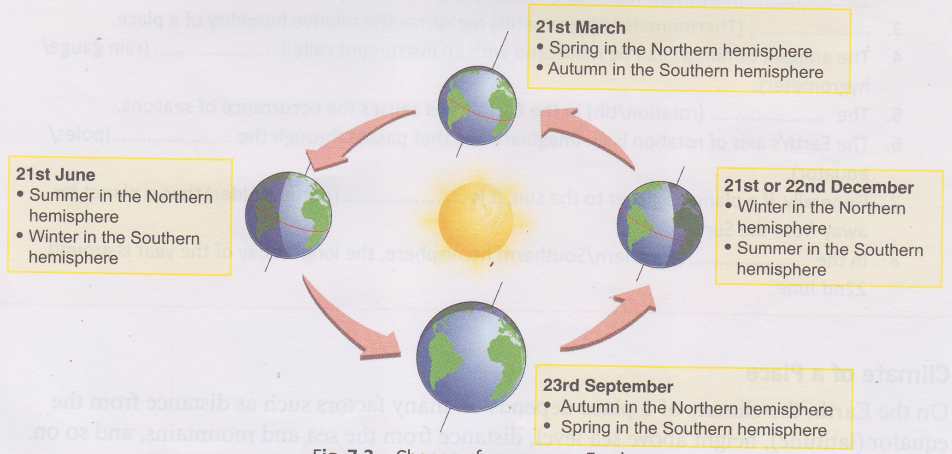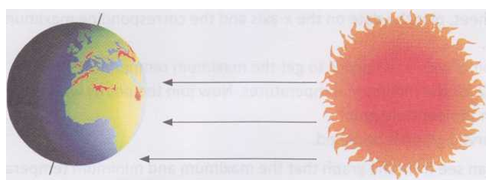How is Climate differ from Weather
Weather tells us about the changes that take place in the atmosphere at a given place and time. Weather forecasts are given regularly on television and in the newspapers.
Terms like hot, cold, humid, rainy, cloudy, etc./are the factors that are generally mentioned in a weather forecast. The weather of a place can change within a very short span of time. For example, you could wake up to a very bright and sunny day, and end up with heavy rains in the afternoon.
In this chapter, you will learn about weather, climate, the factors they depend on, and how animals adapt to the climatic conditions of their natural habitats.
Weather and Climate
The state of the atmospheric conditions like temperature, humidity, rainfall, snow, cloud cover, wind, etc. at a given place and time is called the weather of the place at that time. Temperature, humidity, rainfall, snow, cloud cover, wind, etc. are called weather elements. The characteristic pattern of weather elements in a place over a period of time is called climate of the place.
Both weather and climate affect our lives in many ways. Our way of living, the clothes we wear, the crops we grow, the food we eat, and many other things depend on the weather, and subsequently, the climate of the place that we live in.
Weather forecast is a prediction of the weather conditions for a place over a short period of time like the next few days. In order to make weather forecasts, scientists need to monitor the weather elements every day.
A special thermometer called the maximum- minimum thermometer is used to measure the maximum and minimum temperatures in a day.
 The relative humidity of the air is measured by an instrument called a hygrometer. The amount of rainfall is measured by an instrument called the rain gauge.
The relative humidity of the air is measured by an instrument called a hygrometer. The amount of rainfall is measured by an instrument called the rain gauge.
Climate tells us what it is like in the place where we usually live. For example, if we say that in the month of June, we expect it to be mild in Bengaluru, humid in Kolkata, hot and dry in Rajasthan, cold in Ladakh, and rainy in Kerala, then we refer to the climate of that place.
Factors that affect the climate of the Earth
The climate of the Earth has not remained the same through the ages. There have been periods when it has been extremely cold, as in the Ice Ages, when large areas of the Earth’s surface were covered with ice.
With the advance in science and technology and powerful computers, scientists are now able to simulate the Earth’s climate using a simplified model and study how various factors affect it. The study of climate is fast emerging to be a very exciting and challenging field of science.
Climate of the Earth as a Whole
Some of the factors that affect the climate of planet Earth as a whole are: the distance from the Sun and the Earth’s tilt.
1. Distance from the Sun
If you move closer to a lit stove you will feel warmer than when you are away from it. Similarly, the planet closest to the Sun is much hotter than the planet farther away from it. This is because the Sun is like a hot ball of fire.
The distance of the Earth from the Sun plays a major role in determining the temperature on the surface of the Earth and therefore its climate.
2. Earth’s Tilt
The Earth rotates about its axis (which is an imaginary line joining the North Pole and the South Pole).

The axis about which the Earth rotates, around the Sun, is at an angle with the plane of its orbit around the Sun. The angle that the Earth’s axis of rotation makes with the direction perpendicular to the plane of the Earth’s orbit around the Sun is called angle of inclination. This is about 23.5°. Inclination would have been zero if the Earth’s axis was perpendicular to the plane of its orbit around the Sun. It is this tilt in the Earth’s axis as well as revolution of the Earth around the Sun that causes the occurrence of seasons on the Earth. From 21st March to 23rd September, the Northern hemisphere is closer to the Sun. So, it is hotter than the Southern hemisphere, which is farther away from the Sun. The reverse happens in the next half of the orbit.

Change of seasons on Earth
Sunrise and Sunset
The length of a day is given by the difference in the times of the sunrise and sunset. It is not the same throughout the year because the area of the Earth’s surface lit by the Sun varies due to the Earth’s tilt and its position in its orbit around the Sun. In the Northern hemisphere, the longest day of the year is around 22nd June and the shortest day is around 22nd December.
Activity
Aim: To plot a graph of changes in length of the day
Materials needed: A centimetre graph sheet, data from your local newspaper for at least ten days, a sharp pencil, and an eraser
Method:
1. Note the time of sunrise and sunset from the daily newspaper for ten consecutive days.
2. Find the difference in the times to get the duration of each day, i.e., day length.
3. On a graph sheet, plot the date on the x-axis and the day length on the y-axis.
Observation: A curved graph is obtained.
Conclusion: You will see that the length of a day changes.
Climate of a Place
On the Earth, the climate of a place depends on many factors such as distance from the equator (latitude), height above sea level, distance from the sea and mountains, and so on.
1. Distance from the Equator (Latitude)
Places closer to the equator are warmer than the places closer to the poles. For example, it is much warmer in India (on an average, not taking into account exceptions like the higher reaches of the Himalayas) than Greenland. This is because the Sun’s rays fall directly on the equator and at an angle on the poles.

Sun’s rays falling on Earth
2. Height Above Sea Level and Distance from the Sea and Mountains
Why do people visit hill stations during summer? They do so because hill stations have a cooler climate than the plains. The higher a place is, the cooler it is. The sea has a moderating influence on the climate of a place.
 The places near the coast, such as Mumbai, Chennai, and Kolkata, are neither too hot nor too cold. On the other hand, places far away from the sea tend to have extreme climates with very hot summer and very cold winter.
The places near the coast, such as Mumbai, Chennai, and Kolkata, are neither too hot nor too cold. On the other hand, places far away from the sea tend to have extreme climates with very hot summer and very cold winter.
You would have also learned how the Coastal areas are neither hot nor cold.
Himalayas affect the climate of North
India. Mountains can change or even stop winds and also influence the rainfall in a place.
Weather of a Place
Weather of a place is described by the temperature and humidity of that place.
1. Temperature
The temperature on any day depends (among other factors) on the amount of sunlight received. It is generally cooler during the nights than in the day time. One of the main reasons for this is that during the day, the rays of the Sun heat up the Earth. Temperatures may be many degrees higher in urban areas than in rural areas because of various factors such as pollution, higher density of people and houses, less number of trees, etc.
Activity
Aim: To plot a graph of daily changes in temperature
Materials needed: A centimetre graph sheet, temperature data from your local newspaper for at least ten days, and red and blue pencils.
Method:
1. Note down the date and the maximum and minimum temperatures from the newspaper for ten days.
2. On a graph sheet, plot the date on the x-axis and the corresponding maximum temperatures on the y-axis.
3. Join these points with a red pencil to get the maximum temperature graph.
4. Repeat Step 2 for the minimum temperatures. Now join the points with the blue pencil to get the minimum temperature graph.
Observation: A curved graph is obtained.
Conclusion: You can see from the graph that the maximum and minimum temperatures change daily.
2. Humidity
The amount of water vapour present in the atmosphere determines humidity. A drier place will have lower humidity. Places near the sea coast, like Kolkata and Mumbai, generally have greater humidity than places far away from the sea, like Delhi and Uttar Pradesh. Humidity of a region is usually higher in the rainy season than during summer and winter.
